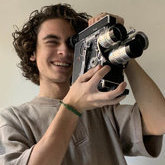-
Posts
18 -
Joined
-
Last visited
-

Underexposing KV3 7219
Alberto Bañares replied to Alberto Bañares 's topic in Film Stocks & Processing
It's good to know, thanks Tyler! -

Underexposing KV3 7219
Alberto Bañares replied to Alberto Bañares 's topic in Film Stocks & Processing
Hey Tyler, vimeo compression reduced the natural grain of the film... when were grading it and checking it on a glorious calibrated monitor the grain had another intensity. But as we knew then, that was the only time we would see it that way. -

Underexposing KV3 7219
Alberto Bañares replied to Alberto Bañares 's topic in Film Stocks & Processing
Thanks Karim, I do hope we can shoot on film more and more... -

Underexposing KV3 7219
Alberto Bañares replied to Alberto Bañares 's topic in Film Stocks & Processing
Thanks Robino! -

Underexposing KV3 7219
Alberto Bañares replied to Alberto Bañares 's topic in Film Stocks & Processing
Hey Heikki, We were able to work in the foreground in some scenes, mixing our light with the natural available light . In others we would add some color in the background and in others we would use astera tubes and other LED sources to "salt&pepper" the frame, and make it more cinematic. Our light package was extremely small, a 2K, one S60, one Kinoled, asteras and some small led RGB units. Thanks! A. -

Underexposing KV3 7219
Alberto Bañares replied to Alberto Bañares 's topic in Film Stocks & Processing
Hello there! I just wanted to share with you the music video, where I pushed the 7219: underexposed 1 stop all the night scenes as well as the bar and pushed it on the color grade. All the best! -

Underexposing KV3 7219
Alberto Bañares replied to Alberto Bañares 's topic in Film Stocks & Processing
Thanks Tyler for your extensive reply. I agree with you, I'd never push (Digitally or photochemically) S16mm 2 stops, but certainly I'd like to do so with 35mm film if needed be. All the best, a. -

Underexposing KV3 7219
Alberto Bañares replied to Alberto Bañares 's topic in Film Stocks & Processing
Hi Karim, Yeah, I had seen Drew's test before... he has another great test of 5219 pushed 2 stops, very useful! In this particular test, I'm surprised by the small amount of grain... Drew says in his comments that Vimeo's compression actually reduced the grain. Also, he's actually not compensating a full stop, as he's rating it at 800ISO, so he's getting a cleaner image. Then there is the Film Lab variable, as probably depending on the quality of the chemicals and other factors, you can get a cleaner negative. I heard the other day on a Team Deakins podcast a DP talking about how they used to test different Labs sending them the same footage in order to see all the differences... Also my project was mainly night exteriors, and although we managed to get streets with already good lighting conditions (and I've been able at some degree to light the foreground), I was afraid that a normal push process would produce more grain than compensating it on the color grade. A big chunk of Drew's test has well lit interiors and sunny exteriors, but I was surprised to see the quality in the low light scenes he has. Thanks for the interest on my project, Karim! A. -

Underexposing KV3 7219
Alberto Bañares replied to Alberto Bañares 's topic in Film Stocks & Processing
Hi Giray, I'm aware of what you say, in fact Harris Savides was doing a combination of things but mainly underexposing 2 to 3 stops as far as I know (in Birth, for example)... but in this case, I'm not printing up, I'm compensating that in the grade after receiving the normal Log 2K scan. I guess it's another way of printing up... Ideally, a test would have been great... but we couldn't afford it! -

Underexposing KV3 7219
Alberto Bañares replied to Alberto Bañares 's topic in Film Stocks & Processing
Hi Stuart, That test would have been great indeed... as I'd have loved to know which kind of push was cleaner. Somehow in my mind it made more sense (after knowing that other DPs have used the same push technique) the idea of a cleaner push in postproduction as the film's latitude is generous. The music video I shot will be released in 10 days and I'm very happy with the results, I will share it here. Thanks for your reply! A. -

Underexposing KV3 7219
Alberto Bañares replied to Alberto Bañares 's topic in Film Stocks & Processing
Hi Karim, Probably is not a great idea to push 7219, but pushing 5219 is another thing, don't you think? Btw, do you mean that because pushing helps the films' density it would help to do contact prints with less "light"? First time I've heard/read about this, it's quite intriguing... -

Underexposing KV3 7219
Alberto Bañares replied to Alberto Bañares 's topic in Film Stocks & Processing
Thanks Robino, that's what I thought ! Best, A. -
Hello! I'm preparing a music video which will be shot on KV3 7219, mainly in low light conditions at night on exteriors. I want to rate the film at E.I. 1000 ASA but develop it normally at 500ASA in order to avoid the grain that would come from the push process. Later in the grade, my idea is to correct that stop and balance it to 1000 ASA. That's my idea as it's something that I've seen other DPs have done in similar projects on S16mm or S35mm, but my question would be wether that correction can or should be done in the Arriscan (we're doing HD Dailies on a Spirit and then use the Arriscan with the EDL later ) or if am I correct and can be done in the grading? Thanks for your help! A.
-
Hi Marco, I'm curious to know your results, as I was about to set a similar question, red color on S16mm 7219... in my case I was thinking which kind of source would capture more accurately the red color (in my case, red color with a mix of color temperatures in the background ), as I'm doubting on using a RGB Led panel (Skypanel / Kinoled, have both in the light package ) or use a tungsten source with a red gel on it ( which probably will be better, that's what I'm guessing). Have you already shot your project? All the best, A.




